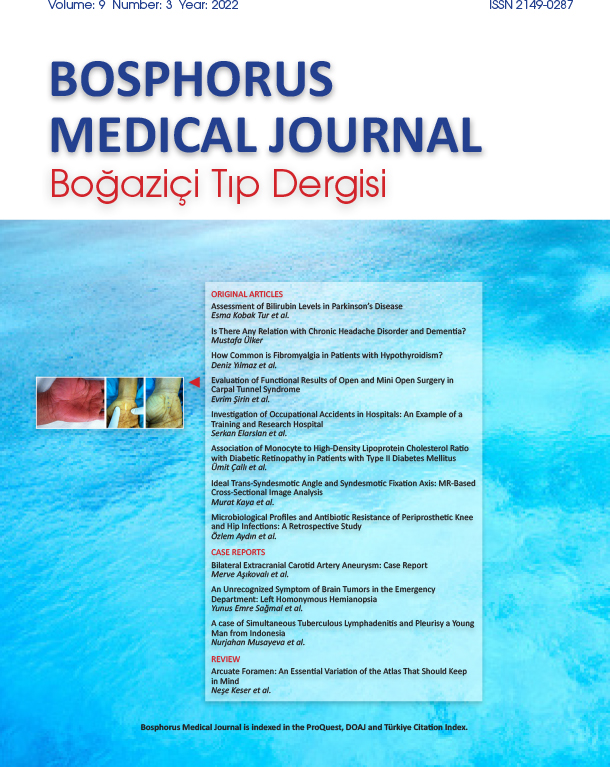Volume: 9 Issue: 4 - 2022
| FRONT MATTERS | |
| 1. | Frontmatters Pages I - VIII |
| ORIGINAL RESEARCH | |
| 2. | The Relationship of CRP/Albumin Ratio with Etiology and Prognosis in Acute Ischemic Stroke Mustafa Ülker, Saime Füsun Domac, Mehmet Demir, Rahşan Karacı doi: 10.14744/bmj.2022.60352 Pages 209 - 215 INTRODUCTION: Inflammation has a role in both the onset and progression of atherosclerosis. C-reactive protein (CRP) and albumin are indicators of inflammation and related to atherosclerosis and stroke. The ratio of CRP to albumin (CAR) is thought to have prognostic significance in systemic inflammation. However, the relationship between CAR and acute ischemic stroke (AIS) is yet to be clarified. METHODS: Between January 2016 and January 2018, 477 patients who were hospitalized in the Neurology Department with a diagnosis of AIS and 189 control cases were examined. Stroke severity of patients who admitted in first 24 h were evaluated with the National Institute of Health Stroke Scale (NIHSS) score. The relationship between CAR and stroke severity, early prognosis, and etiologic subtypes was evaluated. RESULTS: The mean age of patients was 69.54±12.8. While 52.2% of patients were male, 47.8% were female. The mean CAR values were 66.79±9.02 in the patient group and 36.19±3.56 in the control group. There was significant difference between the two groups (p<0.0001). With regard to NIHSS scores, there was significant difference between the mild (score <8), moderate (score 814), and severe (score >14) groups in terms of CAR values (60.7±8.5; 87.7±9.53; and 89.04±12.02) (p=0.0019). The mean CAR values in the atherothrombotic and cardioembolic groups were 94.553±9.36 and 60.974±9.36, respectively, and there was significant difference between the two groups (p=0.004). In terms of early prognosis, the mean CAR value of good prognosis (mRS: 02) and poor prognosis (mRS: 36) patients was 60.72±8.86 and 85.16±9.33, respectively. There was a strong statistical relationship between the CAR values and early prognosis (p<0.001). No statistically significant relationship was found according to either age or gender. DISCUSSION AND CONCLUSION: The strong relationship between high CAR values and stroke severity, bad early prognosis, and atherothrombotic stroke raises the question of whether or not the CAR value can be used as a predictive marker for the prognosis and etiologic subtype of stroke. |
| 3. | The Clinical and Radiological Outcomes of Surgical Decompression in Older Patients with Lumbar Spinal Stenosis Şevki Gök, Merih İş, Alp Karaaslan, Recep Başaran, Neşe Keser, Mehmet Zafer Berkman doi: 10.14744/bmj.2022.51423 Pages 216 - 221 INTRODUCTION: Lumbar spinal stenosis (LSS) is a clinical syndrome of the buttock or lower extremity pain, which may occur with or without back pain, associated with diminished space available for the neural and vascular elements in the lumbar spine. This study aims to analyze the clinical and radiological outcomes of lumbar decompression in patients with degenerative LSS. METHODS: The patients with degenerative LSS in the Department of Neurosurgery of Haydarpasa Numune Training and Research Hospital were included retrospectively. The radiological evaluations were measured with the extreme PACS system (2010) by magnetic resonance imaging. The clinical outcomes were evaluated with visual analog score (VAS) and Japanese orthopedic association (JOA) scores. Odoms criteria were used for outcomes. RESULTS: Thirty-five patients over 65 years old with degenerative LSS were underwent posterior decompression surgery. Of the participants, 40% (n=14) were male and 60% (n=21) were female. The mean age is 63.34±8.08. The area measurements, modified area measurements, AP diameter measurements of the right and left lateral recess, right and left lateral transverse AP diameter measurements, and AP diameter measurements of the right and left neural foramen were improved after surgery. VAS and JOA scores were good after surgery. Fourteen patients had an excellent result, 12 patients had a good result, and nine patients had a fair result according to Odoms criteria. DISCUSSION AND CONCLUSION: Improvements in the VAS and JOA scores are prominent after surgery. Foraminotomy and expansion of the lateral recess during surgery increased the quality of life and improved post-operative radiologic parameters in over 65 years of age with degenerative LSS. |
| 4. | The Prevalence and Correlates of Sleep Disturbances and Psychological Symptoms in Healthcare Workers: A Multi-Center Cross-Sectional Study Sacit İçten, Gülcan Koyuncu doi: 10.14744/bmj.2022.53315 Pages 222 - 233 INTRODUCTION: In this study, we aimed to investigate daytime sleepiness, sleep quality, and psychological symptoms in healthcare workers and to examine the relationship between them. METHODS: This survey study is descriptive and cross-sectional study. The population of the study consists of 1126 healthcare workers in six public health institutions in Istanbul. The study data were collected with a piece of personal information from questioning sociodemographic information, Epworth Sleepiness Scale (ESS), Pittsburgh Sleep Quality Index (PSQI), and the Brief Symptom Inventory that determine the psychological symptom status. The data were analyzed with SPSS 26 package program. RESULTS: Data for 1126 participants who were 22.9% male and with a mean age of 32.10 (±8.83) years were analyzed. It was determined that there is a large mental health burden on healthcare workers. In general, excessive daytime sleepiness, reduced sleep quality, and psychopathological symptoms were significantly higher than the normal population. They were 19.2%, 52.0%, and 45.7%, respectively. A significant correlation was found between sleep disorders and psychopathological symptoms. It was observed that the ESS and PSQI scores varied according to gender, occupation, and shift status. The difference was statistically significant (p<0.05). There was no difference in daytime sleepiness and sleep quality according to the type of work in those with psychopathology symptoms (p: >0.05). DISCUSSION AND CONCLUSION: The heavy workload and work stress cause sleep problems and psychological symptoms in healthcare workers. To quality and efficient healthcare, working conditions and hours of healthcare workers should be regulated, and training on stress management and sleep hygiene should be provided. |
| 5. | Investigation of the Relationship Between Thyroid Function Tests and COVID-19: A Retrospective Study Hakan Aydın, Halil Doğan doi: 10.14744/bmj.2022.39358 Pages 234 - 241 INTRODUCTION: The coronavirus disease 2019 (COVID-19), causing a worldwide pandemic, affects various organs and systems. The effects of COVID-19 on the thyroid axis remain uncertain. Our aim is to examine the changes in thyroid function tests in patients with COVID-19 and to evaluate the effectiveness of these changes in predicting the prognosis. METHODS: This retrospective study was conducted in 1891 adult patients visited to the emergency department with suspected COVID-19. The diagnosis of COVID-19 was confirmed by reverse transcriptase-polymerase chain reaction (rt-PCR), and patients were divided into two groups as those with and without COVID-19. COVID-19 patients were divided into groups according to their clinical severity and prognosis. The groups were compared in terms of free triiodothyronine (FT3), free thyroxine (FT4), and thyrotropin (TSH) levels. RESULTS: The rate of laboratory-confirmed COVID 19 patients was 54.7% in the patients included in the study. In COVID-19 patients, the hospitalization rate was 56.7%, the intensive care unit admission rate was 7.7%, and the in-hospital mortality rate was 5.4%. Most of the COVID-19 patients (60.1%) were euthyroid. Hyperthyroidism (overt 3.7%-1.3%, p=0.001; secondary 13.64.6%, p<0.001) and non-thyroid illness syndrome (NTIS) (18.93%, p<0.001) were more common in COVID-19 patients than in non-COVID19 patients. Patients with COVID-19 had lower TSH and FT3 levels and higher FT4 levels compared to those without COVID-19. Similarly, among COVID-19 patients, lower TSH and FT3 and higher FT4 levels were seen in deceased patients compared to survivors (p<0.001). DISCUSSION AND CONCLUSION: High FT4 levels combined with low TSH and FT3 levels may represent a type of NTIS that occurs in the acute phase of COVID-19. This pattern appears to be predictor of poor outcome of patients with COVID-19. |
| 6. | The Evaluation of Effectiveness of Pedicle Subtraction Osteotomy on Thoracic Level in Spinal Deformity Patients Emre Bal doi: 10.14744/bmj.2022.82687 Pages 242 - 247 INTRODUCTION: Classical instrumentation may be insufficient in the surgical treatment of rigid spinal deformities with structural changes in bone tissue. Many different types of osteotomy have been described to correct such rigid deformities. In this study, we aimed to evaluate the clinical and radiological results of pedicle subtraction osteotomy (PSO) applied at the thoracic level in patients with coronal and/or sagittal plane spinal deformity. METHODS: 61 of the 123 cases, who underwent PSO for spinal deformity between 2010 and 2013, were included in the study. Pre- and post-operative ortho-radiography was performed; angles (scoliosis, kyphosis, and lordosis angles) and global sagittal balance were measured. Duration of operation, bleeding and complications were noted. SF-36 scoring was used for clinical outcome. RESULTS: This study was consist of 30 male and 31 female patients including 28 scoliosis, 23 kyphosis and 10 ankylosing spondylitis cases. Post-operative mean Cobb angle was 62%, sagittal balance was 42%, kyphosis angle was 38%, thoracic kyphosis angle was 61%, and lordosis angle was 19.44% corrected (p<0.001). When radiological data were evaluated, significant improvement was observed in the angles of kyphosis and lordosis after PSO surgery. The eight parameters of SF-36 showed an increase in all patients, while the least change was observed in the pain parameter. DISCUSSION AND CONCLUSION: PSO surgical technique is effective in patients with spinal deformity with sagittal balance disturbance at the lumbar region as well as thoracic level. |
| 7. | The Effect of Thyroid Disorders on Mortality and Clinical Outcomes in Geriatric Hip Fractures Olgun Bingöl, Güzelali Özdemir, Burak Kulakoğlu, Taner Karlıdağ, Enver Kılıç, Fatih İnci doi: 10.14744/bmj.2022.42204 Pages 248 - 252 INTRODUCTION: The aim of this study was to investigate the effect of thyroid dysfunctions on post-operative mortality and clinical outcomes in patients with geriatric hip fractures. METHODS: In this retrospective study, 139 patients applied to the hospital with hip fractures between January 2019 and October 2020 were included in the study. The patients were divided according to thyroid function tests into three groups as euthyroid, hypothyroid, and hyperthyroid, respectively. Group 1 consisted of 97 patients within the euthyroid boundaries. Group 2 consisted of 18 patients with hypothyroidism and Group 3 consisted of 24 patients with hyperthyroidism. The effect of the thyroid disorders on 30-day and 1-year mortality was evaluated. Moreover, need for intensive care unit (ICU) and the length of stay (LOS) in ICU were examined between the groups. RESULTS: The 30-day mortality rate in the patients included in the study was 6.5% and the 1-year mortality rate was found to be 23.7%. Forty-four of 139 patients included in the study needed for the ICU. The 30-day and 1-year mortality rates in the hypothyroid patient group were found to be 16.6% and 22.2%, respectively. About 55.6% of the hypothyroid group, significantly higher than the other groups, were treated in the ICU (p=0.045). The mean LOS of the patients included in the study was 7.14±4.61 days. The mean LOS in Group 2 was observed to be longer than in Groups 1 and 3; however, this difference was not statistically significant (p=0.330). DISCUSSION AND CONCLUSION: In geriatric hip fractures with hypothyroidism in the pre-operative period, the need for ICU and the LOS in ICU increased in the post-operative period. Therefore, it is recommended that geriatric hip fracture patients with hypothyroidism should be followed up closely in the perioperative period. |
| 8. | Efficacy of Intravitreal Dexamethasone Implant in the Treatment of Macular Edema Secondary to Retinal Vein Occlusion and Resistant to Intravitreal Ranibizumab Injection Ayşe Ergin, Banu Açıkalın, Sevda Aydın Kurna, Yelda Özkurt, Eda Asılyazıcı, Ayşe Sönmez, Murat Yamiç, Fatih Bilgehan Kaplan, Murat Garlı doi: 10.14744/bmj.2022.93276 Pages 253 - 261 INTRODUCTION: Retinal vein occlusion (RVO) is the second most frequent retinal vascular disease after diabetic retinopathy. Macular edema secondary to RVO is the most prevalent cause of visual loss. The aim of this study was to evaluate the efficacy of intravitreal dexamethasone implant (IVDI) in the treatment of macular edema secondary to RVO and refractory to at least three months of repeated intravitreal ranibizumab injection (IVRI). METHODS: Forty-two eyes of 42 patients who were admitted with RVO to the Department of Ophthalmology, University of Health Sciences, Istanbul Fatih Sultan Mehmet Training and Research Hospital between January 2016 and January 2018 and underwent IVDI for refractory macular edema despite repeated IVRI for at least three months were included in the study. Best corrected visual acuity, intraocular pressure and mean central macular thickness were retrospectively compared at the first, second, third and sixth months after IVDI. RESULTS: The best corrected visual acuity before IVDI was 0.83±0.48 Logarithm of Minimum Angle of Resolution (LogMAR). After IVDI, the best corrected visual acuity happened as 0.55±0.42 LogMAR at the first month, 0.52±0.43 LogMAR at the second month, 0.62±0.47 LogMAR at the third month and 0.75±0.54 LogMAR at the sixth month. Mean central macular thickness before IVDI was 550±156.53 µm. Mean central macular thickness after IVDI evaluated as 427.53±165.52 µm in the first month, 382.8±156.48 µm in the second month, 382.35±160.37 µm in the third month, and 435.83±176.57 µm in the sixth month. A statistically significant increase in best corrected visual acuity and a statistically significant decrease in mean central macular thickness were reported at the first, second and third months after IVDI compared to before IVDI. DISCUSSION AND CONCLUSION: It was observed that IVDI provided an increase in best corrected visual acuity and a decrease in central macular thickness in the treatment of macular edema due to RVO and assessed that repeated injections are needed to maintain this gain. Long-term results are needed to determine whether the inter-injection interval will decrease with repeated injections and whether both intraocular pressure increase and cataract development will change. |
| 9. | Ultra-Fast-Track Extubation Experience in Pediatric Cardiac Surgery Mustafa Şimşek, Şefika Türkan Kudsioğlu doi: 10.14744/bmj.2022.58815 Pages 262 - 265 INTRODUCTION: The efficacy and safety of early extubation after pediatric congenital heart surgery was evaluated. METHODS: Thirty-two patients who underwent pediatric cardiac surgery between 2014 and 2015 were included in the study. Diagnosis of the patients: atrial septal defect (eight patients), ventricular septal defect (seven patients), Fontan procedure (four patients), cavapulmonary anastomosis (six patients), Fallot tetralogy (four patients), abnormal left coronary artery originating from pulmonary artery (two patients), and dual outlet right ventricle was one patient. The duration of cardiopulmonary bypass, cross clamp, extubation, reintubation, and intensive care unit stay of the patients was recorded. RESULTS: The patients were extubated in the operating room (ultra-fast-track extubation) after surgery. One patient required reintubation after 2 h. DISCUSSION AND CONCLUSION: In ultra-fast-track extubation approaches for pediatric cardiac surgery patients, careful pre-operative evaluation, perioperative management, and patient selection together with the characteristics of the cases are very important. In our study, it was observed that early extubation could be performed safely. |
| 10. | Assessment of Patients Monitored for Non-Biliary Acute Pancreatitis in Terms of Etiology, Prognosis, and Mortality Zeynep Koç, Seydahmet Akın, Banu Boyuk, Özcan Keskin doi: 10.14744/bmj.2022.13245 Pages 266 - 271 INTRODUCTION: We planned to investigate the etiologic causes, prognosis, and mortality rates for cases diagnosed with non-biliary acute pancreatitis (AP) monitored by the internal medicine clinic. METHODS: The study included 73 patients monitored by the clinic from January 2016 to June 2021. Patients included in the assessment were investigated for age-sex, presence of chronic disease, local, and systemic complications developing linked to AP, admission to intensive care, incidence of mortality, and clinical follow-up duration. RESULTS: The most frequent etiological cause was idiopathic (40%), followed by hyperlipidemia (24%) and alcohol (6%). Advanced age (65 years and older) was significantly high among patients with high Ranson score (p=0.001; p<0.01). There was no correlation between sex and etiologic cause with prognosis (p>0.05). There was a significant correlation between presence of comorbid disease and high Ranson score (p=0.045; p<0.05). Among cases, 56% were observed to have recurrent AP (RAP) admissions. DISCUSSION AND CONCLUSION: While advanced age and presence of comorbid disease significantly contribute to the severity of AP, our study did not show an effect of etiologic factors on prognosis. RAP was observed in 56% of cases. |
| CASE REPORT | |
| 11. | Myotonia Congenita: Case Report of Beckers Variant Okan Akşahin, Mehmet Güney Şenol doi: 10.14744/bmj.2022.52244 Pages 272 - 275 Myotonia is a finding caused by muscle hyperexcitability and occurs as a result of delayed relaxation. The two disease groups in which myotonia is seen are myotonic dystrophy from muscular dystrophies and non-dystrophic myotonias from muscle ion channel diseases. Congenital myotonia is a rare inherited disease of skeletal muscle characterized by diffuse muscle hypertrophy, non-progressive myotonia, and difficulty in relaxation after sudden muscle contraction. In this article, we present a 59-year-old patient, who applied to the neurosurgery clinic due to increased muscle weakness, pain, and muscle stiffness in the legs for the past 1 year, was diagnosed with spinal stenosis and was referred to us before surgery and was diagnosed with myotonia congenita as a result of clinical evaluation and EMG. Congenital myotonia may have a subclinical course in some patients and may be difficult to diagnose in the presence of concomitant symptomatic spinal cord pathology. It is very important to inform anesthesiologists before surgery to prevent perioperative complications when the diagnosis is made. |
| 12. | İlaç İlişkili Tiroid Miyopati: Hoffmann Sendromu Olgu Sunumu Cansu Gülcihan Türkok, Okan Aksahin, Ceyda Dogan, Mehmet Güney Şenol, Mehmet Fatih Özdağ doi: 10.14744/bmj.2022.09226 Pages 276 - 278 Hypothyroid myopathy is a muscle disease with endocrine disease related abnormal hormone levels and Hoffmans syndrome is a rare form of hypothyroid myopathy. The disease commonly involves muscle weakness, muscle pain, and cramps. In this case, we talked about the clinical and laboratory findings and his good response to hormone replacement therapy of a patient with Hoffmann syndrome who developed due to hypothyroidism myopathy. A 22-year-old male patient, diagnosed with graves 2 years ago, after that he had a bilateral thyroidectomy surgery 1.5 years ago, has been still using L-thyroxine 150 mcg/day. In the patients history, it was learned that intramuscular hormone therapy was administered to his 2 months ago for bodybuilding purposes without the doctors advice. When he applied to us, he was suffering from widespread muscle cramps, muscle pain, and weakness for 1 month. It is learned that he had methyltestosterone injection 2 months ago and after 3 weeks of injections, symptoms had been showed up. In laboratory findings, while sT3, sT4 levels were low, TSH and CK levels were high. On examinations, muscle hypertrophy was more specifically seen on proximal muscles. He is diagnosed with Hoffmanns Syndrome and L thyroxine treatment has rearranged from 150 mcg/day to 250 mcg/day. During the follow-up of the patient, complete improvement was observed in the clinical and laboratory findings and the follow-up, and treatment continues. |
| REVIEW | |
| 13. | The Role of Neutrophils, Lymphocytes, and Platelets in Ischemic Stroke Hatice Ferhan Kömürcü doi: 10.14744/bmj.2022.48030 Pages 279 - 285 Pathological changes developing in acute ischemic stroke are associated with inflammation and immune events. In the process of cerebral ischemia, platelets, neutrophils, and lymphocytes have an important role in inflammatory and immune events. Uncertainties about the effects of blood cells along with immunity in sterile inflammatory response after stroke persist. Blood cells play an important role in the development of ischemic damage in acute stroke. Platelets contribute to the migration of neutrophils from the circulation to the ischemic area to open the path in the vascular wall and enter into the damaged area. Besides, lymphocytes are involved in the damage, sometimes positive and sometimes negative mechanisms in acute stroke. Dynamic changes of these cells may be related to the prognosis, determining the degree of neurological damage of stroke. Investigation of the effects of blood cells as mediators and pathophysiological mechanisms in stroke will contribute to the determination of treatment approaches and prediction of prognosis. This article reviews recent studies on the role of neutrophils, lymphocytes, and platelets in the development and the prognosis of ischemic damage in acute stroke. |




















